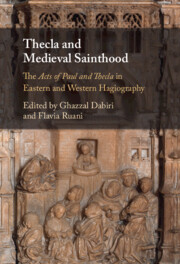Introduction
Published online by Cambridge University Press: 06 May 2022
Summary
Thecla is one of the most prominent figures of early Christianity, and her tale, the Acts of Paul and Thecla, one of the most popular. She has been widely celebrated as the apostle Paul’s disciple and heralded as an apostle in her own right, as a preeminent saint, model of chastity, charismatic confessor, teacher, leader, intercessor, and proto-martyr. Thecla and her tale have been studied from multiple angles (ancient romance, church history, cult, gender, women’s story-telling). However, the tremendous impact Thecla and her tale had on shaping the Lives of saints and their storyworlds remains little studied. This volume offers, for the first time, a collection of papers that explores the reception of Thecla and her tale in medieval (broadly defined) hagiographical texts composed in a variety of languages across Eurasia and North and East Africa. The introduction, thus, sets the stage for analyses by offering a synopsis of the tale, its more famous aspects for medieval readers and modern scholars, and its impact on a broad range of hagiographical tales. It also highlights the most prominent techniques that hagiographers deployed to model their protagonists on Thecla and the methodologies (intertextuality, reception) used across the volume that call them forth.
Keywords
- Type
- Chapter
- Information
- Thecla and Medieval Sainthood<I>The Acts of Paul and Thecla</I> in Eastern and Western Hagiography, pp. 1 - 32Publisher: Cambridge University PressPrint publication year: 2022



